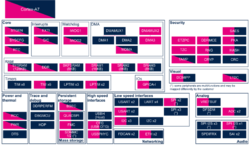1 Peripheral overview[edit source]
The BKPSRAM internal memory is located in the VSW power domain, allowing it to be supplied during Standby low power mode, or to be switched off.
1.1 Features[edit source]
Refer to STM32MP13 reference manuals or STM32MP15 reference manuals for the complete feature list, and to the software components introduced below, to see which features are currently implemented.
1.2 Security support[edit source]
The BKPSRAM is a secure peripheral (under ETZPC control).
2 Peripheral usage and associated software[edit source]
2.1 Boot time[edit source]
The BKPSRAM internal memory is not used during a cold boot or a wake up from Standby with DDR OFF.
The BKPSRAM internal memory is used by the runtime secure monitor (from the FSBL or the OP-TEE secure OS) during wake-up from Standby low power mode with the DDR in Self-Refresh mode. In that case, the BKPSRAM internal memory contains the secure context that has to be restored before jumping back to Linux execution, in DDR.
2.2 Runtime[edit source]
2.2.1 Overview[edit source]
The BKPSRAM peripheral can be allocated to:
- the Arm® Cortex®-A7 secure to be used under PSCI [1] secure services (from the FSBL or OP-TEE secure monitor) to save the secure context before entering Standby low power mode with DDR in Self-Refresh mode. This is the default assignement.
or
- the Cortex-A7 non-secure to be used under Linux® as reserved memory, for instance.
2.2.2 Software frameworks[edit source]
2.2.2.1 On STM32MP13x lines  [edit source]
[edit source]
| Domain | Peripheral | Software components | Comment | |
|---|---|---|---|---|
| OP-TEE | Linux | |||
| Core/RAM | BKPSRAM | PSCI | Linux reserved memory | |
2.2.2.2 On STM32MP15x lines  [edit source]
[edit source]
| Domain | Peripheral | Software components | Comment | ||
|---|---|---|---|---|---|
| OP-TEE | Linux | STM32Cube | |||
| Core/RAM | BKPSRAM | PSCI | Linux reserved memory | ||
2.2.3 Peripheral configuration[edit source]
The configuration is applied by the firmware running in the context to which the peripheral is assigned. The configuration by itself can be done via the STM32CubeMX tool for all internal peripherals, and can then be manually be completed (particularly for external peripherals), according to the information given in the corresponding software framework article.
2.2.4 Peripheral assignment[edit source]
2.2.4.1 On STM32MP13x lines  [edit source]
[edit source]
Click on the right to expand the legend...
Check boxes illustrate the possible peripheral allocations supported by STM32 MPU Embedded Software:
- ☐ means that the peripheral can be assigned (☑) to the given runtime context.
- ⬚ means that the peripheral can be assigned to the given runtime context, but this configuration is not supported in STM32 MPU Embedded Software distribution.
- ✓ is used for system peripherals that cannot be unchecked because they are statically connected in the device.
Refer to How to assign an internal peripheral to an execution context for more information on how to assign peripherals manually or via STM32CubeMX.
The present chapter describes STMicroelectronics recommendations or choice of implementation. Additional possiblities might be described in STM32MP13 reference manuals.
| Domain | Peripheral | Runtime allocation | Comment | ||
|---|---|---|---|---|---|
| Instance | Cortex-A7 secure (OP-TEE) |
Cortex-A7 non-secure (Linux) | |||
| Core/RAM | BKPSRAM | BKPSRAM | ☐ | ⬚ | Assignment (single choice) |
2.2.4.2 On STM32MP15x lines  [edit source]
[edit source]
Click on the right to expand the legend...
Check boxes illustrate the possible peripheral allocations supported by STM32 MPU Embedded Software:
- ☐ means that the peripheral can be assigned (☑) to the given runtime context.
- ⬚ means that the peripheral can be assigned to the given runtime context, but this configuration is not supported in STM32 MPU Embedded Software distribution.
- ✓ is used for system peripherals that cannot be unchecked because they are statically connected in the device.
Refer to How to assign an internal peripheral to an execution context for more information on how to assign peripherals manually or via STM32CubeMX.
The present chapter describes STMicroelectronics recommendations or choice of implementation. Additional possiblities might be described in STM32MP15 reference manuals.
| Domain | Peripheral | Runtime allocation | Comment | |||
|---|---|---|---|---|---|---|
| Instance | Cortex-A7 secure (OP-TEE) |
Cortex-A7 non-secure (Linux) |
Cortex-M4 (STM32Cube) | |||
| Core/RAM | BKPSRAM | BKPSRAM | ☐ | ☐ | Assignment (single choice) | |
3 References[edit source]

